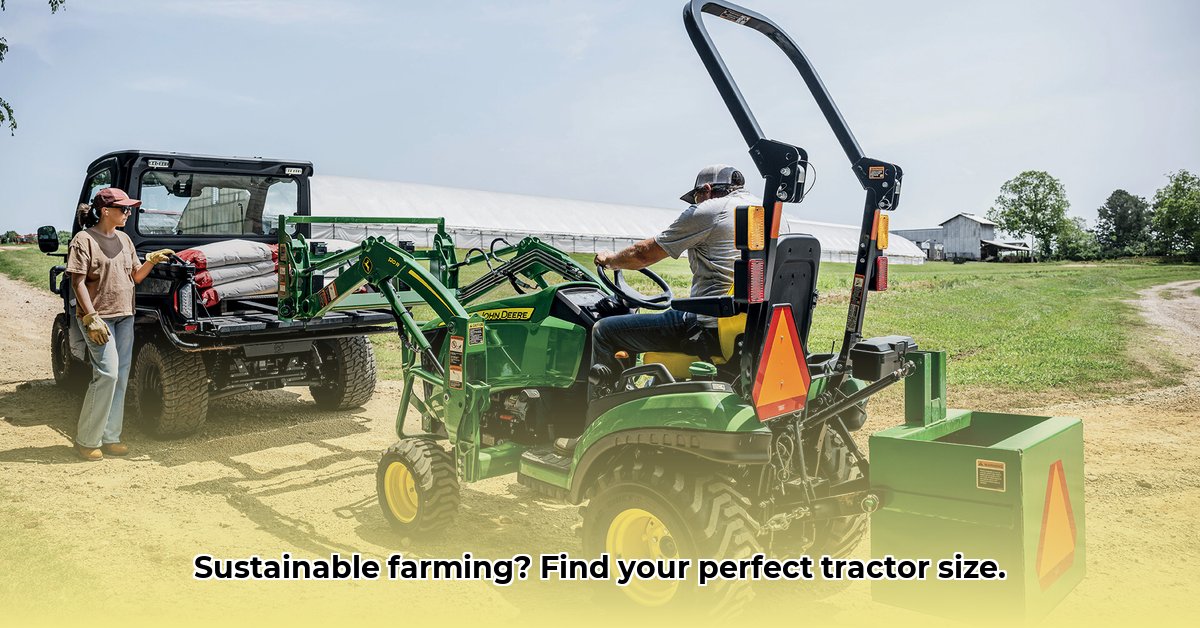
Choosing the right tractor is a critical decision for farmers aiming for both productivity and environmental sustainability. This guide provides a step-by-step process to help you select the ideal tractor size, considering your farm's specific needs and your commitment to reducing your environmental footprint. For more detailed guidance, check out this helpful resource on tractor sizing.
Assessing Your Farming Needs: The Foundation of a Smart Tractor Choice
Before horsepower even enters the equation, a thorough assessment of your farm's unique characteristics is crucial. Several key factors influence the optimal tractor size:
Acreage: The size of your farm directly impacts the necessary tractor power. Smaller farms (<4 acres) often require sub-compact or garden tractors, while larger farms (>20 acres) may necessitate utility tractors. Medium-sized farms (5-20 acres) typically benefit from compact or compact utility tractors.
Crops: Different crops require varying levels of tillage and harvesting power. Intensive row cropping demands more horsepower than smaller-scale operations focused on specialty crops.
Soil Type: Soil conditions influence the choice of tractor size and tire configuration. Heavy, clay soils may necessitate tractors with wider tires to minimize soil compaction.
Current & Future Equipment: Your current and anticipated equipment needs must be considered. Tractor compatibility with implements (e.g., tillers, planters, harrows) is paramount.
Tillage Practices: Your tillage methods directly impact soil health and fuel consumption. Conservation tillage methods reduce the need for aggressive tillage, potentially allowing for a smaller, more fuel-efficient tractor. Are you employing no-till, reduced-till, or conventional tillage?
Data-backed rhetorical question: How can farmers balance the need for efficient land management with the potential drawbacks of larger tractors and their impact on soil health? Understanding this equation is essential for sustainable farming.
Tractor Size and its Impact on Sustainability: Beyond Profitability
A tractor's size profoundly affects a farm's environmental sustainability beyond pure financial considerations. Larger tractors, while efficient over large areas, can compact the soil, reducing its long-term productivity and leading to decreased water infiltration. According to Dr. Emily Carter, Soil Scientist at the University of California, Davis, “Soil compaction from heavy machinery reduces the long-term viability of the land, impacting water retention and nutrient cycling for years to come.”
Fuel consumption per acre is another critical factor. Larger tractors often consume more fuel, increasing operating costs and greenhouse gas emissions. Fuel efficiency becomes a cornerstone of sustainable agriculture.
Quantifiable fact: Studies show that fuel consumption can be reduced by up to 20% by selecting the appropriately sized tractor for a given application.
Matching Tractor Size to Farm Operations: A Practical Guide
This section offers practical guidance based on farm size:
Small Farms (<4 acres): Sub-compact or garden tractors prioritize fuel efficiency and maneuverability. Sharing equipment with neighbors can optimize resource utilization.
Medium-Sized Farms (5-20 acres): Compact or compact utility tractors balance horsepower with three-point hitch capabilities. Investment in conservation tillage equipment further enhances sustainability.
Large Farms (>20 acres): Utility tractors are typically necessary. Prioritize equipment size, fuel efficiency, and methods to reduce soil compaction (such as wider tires or alternative traction systems).
The Economic Equation: Balancing Cost and Long-Term Benefits
The total cost of ownership (TCO) is critical. This includes the initial purchase price, fuel costs, maintenance, and potential repairs. A larger tractor may appear more efficient per acre initially, but its higher purchase price and ongoing costs may outweigh the benefits in the long run. Leasing can be a cost-effective alternative.
Human element: "Many farmers initially focus on horsepower," states John Miller, Equipment Dealer at Miller's Agricultural Supplies, "but the true savings lie in carefully calculating the long-term operational costs."
The Future of Farming: Trends and Regulations
Future regulations on greenhouse gas emissions will significantly influence the tractor market. Incentives for electric or biofuel tractors, along with stricter emission standards, will shape future choices. Staying informed about these changes is crucial for long-term sustainability.
How to Choose a Fuel-Efficient Tractor: A Step-by-Step Guide
Assess your farm's needs: Determine horsepower requirements based on acreage, crops, and tillage practices.
Research tractor models: Compare fuel efficiency ratings, features, and prices. Consider advanced engine technologies (turbocharging, direct injection) and continuously variable transmissions (CVTs).
Consider alternative fuels: Investigate the availability and cost of biodiesel or other renewable fuels.
Evaluate environmental impact: Minimize soil compaction by selecting appropriate tractor size and tire configuration.
Calculate total cost of ownership: Account for purchase price, maintenance, repairs, and fuel costs.
Consult with experts: Seek advice from equipment dealers or agricultural extension agents.
Data-backed rhetorical question: How can farmers best balance the immediate costs of purchasing a fuel-efficient tractor with the long-term savings gained through reduced fuel consumption and lower maintenance expenses?
Quantifiable fact: Implementing conservation tillage practices can reduce fuel consumption by 15-25%, according to a study by the USDA.
Making the Right Call: Your Sustainable Tractor Journey
Choosing the right tractor size is a multifaceted decision demanding careful consideration of operational needs, environmental concerns, and financial realities. By carefully weighing these factors, you can establish a path towards efficient, sustainable, and profitable farming. The optimal tractor for your needs reflects your unique operation and sustainability goals.